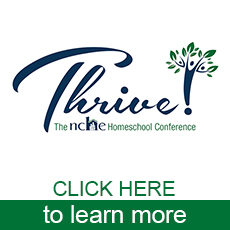
Update Your Homeschool Files!
Out in Facebook-land, I’ve recently seen a flood of questions about DNPE contacting schools open longer than seven years. So, it’s time for a bit of background and encouragement for everyone to update their files on a yearly basis.
The Background
We’ve known the DNPE database has had inaccuracies for a long time, primarily because people forget to close their schools when they are finished homeschooling or move out of the state. When people move within the state, they fail to log in and update their addresses. As a result, when DNPE sends out any mailing, the number returned with “undeliverable” is staggering. Once DNPE improved online accounts for administrators, they encouraged everyone to update their files annually.
Knowing that many people have not closed their schools or updated addresses, for the past couple of years, there has been an effort by DNPE to clean up the data. Notices went out to people with schools open longer than seven years with no updates to their DNPE files. They received notices that their schools could be closed if files were not updated; some people found their schools unexpectedly closed. These notices tended to go out regionally because DNPE had a small staff working hard to support home and private schools.
Fast forward a bit to last fall. DNPE requested funding from the NC General Assembly (GA) for a database server because the capacity was too small, especially given the number of new schools opened during COVID. The reported growth was significant enough to prompt questions from the GA. Not surprisingly, when the GA found out the database was inaccurate, they started asking more questions, which brings us to today.
The Current Status
In the budget bill currently before the GA, DNPE is now required to gather a significant amount of data about homeschools to help the GA know the picture of schools opened during COVID and subsequently closed, numbers of homeschooled students by grade, etc. Money has been given to DNPE to hire temporary help to work on the database. This funding is not for the needed new server. There are plans to contact every homeschool that has not updated the database with current enrollment and test information (date and type only). How and when this might begin is not yet clear, but there is pressure for DNPE to be able to accurately report data to get the funding to handle more homeschools. Homeschools that have been open for seven years or more and haven’t contacted DNPE in the past three years will receive an email request to update their records or to call DNPE to confirm that the homeschool is still operating. DNPE will use email, US mail and the telephone in an effort to contact homeschools. If DNPE is unable to get a response from the homeschool administrator, the school will be closed.
What You Need to Do
First of all, don’t panic! It is appropriate for the GA to expect reasonably accurate data according to the law. It is also proper to have good information when increased funding is requested to give a more precise picture of the homeschooling community. Update your file as soon as possible, and then review and update your data every year from here on out. A good time to update your file would be when you have completed testing for the year. If you are finished homeschooling in NC, by law, you must close your school; please do so immediately if you haven’t already.
DNPE has begun to ask that you enter your testing information into your online records. While this requirement is not spelled out in the law, NCHE recommends that you provide this information. They do not want to see your scores—only confirmation of completion. Think of it in terms of an online inspection. If you add the test used and the date (never put the scores in), then, DNPE knows that you did, in fact, administer a test and are therefore legally continuing to homeschool. It’s nothing new and nothing you aren’t already required to have for DNPE.
If your school was closed by DNPE when you are still actively homeschooling, contact DNPE, and they will be happy to help you get it reestablished. It will be helpful if you have two to three years of test scores to show continuity and give credence to the fact that you have continued to homeschool. Minimally, you should have the last test results by legal requirement.
If we all do our part to keep the data current, there is less reason for increased scrutiny regarding the homeschooling community. It’s an essential part of our roles as school administrators. Let’s all work together to keep NC one of the best states for homeschooling!
Diane Helfrich is a retired homeschooler of fourteen years. She and her husband David have two children that have both gone on to receive graduate and postgraduate education. Now, she serves as the NCHE Development Director and enjoys cooking, reading, and playing ukulele in her spare time.
Cover image by Pexels from Pixabay.
Teaching Children to Value Their Food
by Jessica Frierson, June 2022
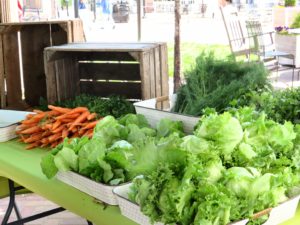 Do your children know where their food comes from? If their answer to that question is the name of a grocery store, then it may be a good time to head to your local farmer’s market or, even better, an area farm. Why is this an important concept for them to understand? Giving a child a better understanding of the source of their food helps them to eat smarter, eat healthier, enjoy the food they eat, and develop an appreciation for what they eat.
Do your children know where their food comes from? If their answer to that question is the name of a grocery store, then it may be a good time to head to your local farmer’s market or, even better, an area farm. Why is this an important concept for them to understand? Giving a child a better understanding of the source of their food helps them to eat smarter, eat healthier, enjoy the food they eat, and develop an appreciation for what they eat.
We gain a greater appreciation for things when we understand their worth. When a child sees a bag of potatoes or a cluster of grapes on their table at home, they cannot begin to comprehend all that went on behind the scenes in order for that to be produced. Seeing fields being prepared for planting, intricate irrigation systems set up to keep the crops watered, and learning about the effort that goes into harvesting crops will help children value their food more.
 This in turn will help our children become more conscious consumers who understand the importance of supporting our local and regional economies. According to Michigan State University Extension office, in 2012 only ten cents out of every dollar that was spent on food made it back to the farmer who grew it. One way we can help our local farmers get a greater return on the investment of their time, cost, and labor is to shop at a farmer’s market as often as possible. Although summer is the season where you can find a greater variety of fresh produce, don’t forget to visit in the off-season as well. Many communities now offer year-round farmers markets that carry seasonal produce, honey, hand-made soaps, fresh baked goods, and farm-raised meat and dairy products. Many farmers markets now accept EBT/SNAP and even double the value of it, further helping out many families.
This in turn will help our children become more conscious consumers who understand the importance of supporting our local and regional economies. According to Michigan State University Extension office, in 2012 only ten cents out of every dollar that was spent on food made it back to the farmer who grew it. One way we can help our local farmers get a greater return on the investment of their time, cost, and labor is to shop at a farmer’s market as often as possible. Although summer is the season where you can find a greater variety of fresh produce, don’t forget to visit in the off-season as well. Many communities now offer year-round farmers markets that carry seasonal produce, honey, hand-made soaps, fresh baked goods, and farm-raised meat and dairy products. Many farmers markets now accept EBT/SNAP and even double the value of it, further helping out many families.
Shopping at the farmer’s market not only helps our local farmers, it also gives our families the chance to eat healthier.  The fresher our food is, the healthier it will be. Purchasing directly from the person who grew your food gives you the opportunity to be more informed about it. You can ask what, if any, chemicals were used for pest control or as fertilizers. You can get recipe ideas and cooking suggestions. When I was purchasing a cantaloupe last week from a local vendor, they asked me if I was planning to eat it that day or needed one that would keep a little longer. You may also find varieties of fruits and vegetables that are not available at the supermarket, such as the golden zucchini I also found that day.
The fresher our food is, the healthier it will be. Purchasing directly from the person who grew your food gives you the opportunity to be more informed about it. You can ask what, if any, chemicals were used for pest control or as fertilizers. You can get recipe ideas and cooking suggestions. When I was purchasing a cantaloupe last week from a local vendor, they asked me if I was planning to eat it that day or needed one that would keep a little longer. You may also find varieties of fruits and vegetables that are not available at the supermarket, such as the golden zucchini I also found that day.
Many farmers markets now include far more than just the produce of their fields and orchards. As the advantages of free-range eggs, farm-raised meats, and fresh milk have become more recognized, consumer access to these products has improved. Family farms often welcome visitors to explore their facilities where they can see firsthand the cows grazing in the pastures or their milk parlors. Local butchers are also a good source of fresh meat as well as a great learning experience. Many will be pleased to show you where the various cuts of meat are taken from on the animal and offer advice on how to best cook different types of cuts.
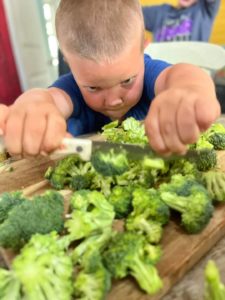 As you shop with your child, you can discuss what vitamins and minerals your body needs and which foods are good sources of those. When children have a part in selecting their food, they are more likely to eat it. The colorful artistry of a vegetable display may inspire your picky eater to try a food they would normally reject. Knowing that their body needs vitamin A to build a healthy immune system, fight cancerous cells, see better, and prevent acne may make a child more likely to eat some carrots, sweet potatoes, or red peppers. Teach them to “eat a rainbow,” then let them help to plan out a rainbow-inspired menu.
As you shop with your child, you can discuss what vitamins and minerals your body needs and which foods are good sources of those. When children have a part in selecting their food, they are more likely to eat it. The colorful artistry of a vegetable display may inspire your picky eater to try a food they would normally reject. Knowing that their body needs vitamin A to build a healthy immune system, fight cancerous cells, see better, and prevent acne may make a child more likely to eat some carrots, sweet potatoes, or red peppers. Teach them to “eat a rainbow,” then let them help to plan out a rainbow-inspired menu.
Meeting the people who grow the food they eat helps a child to be more connected to their community. They learn to see the interconnectedness of the world around them. Integrating them in the process of choosing and acquiring their food transforms them from a passive consumer into someone who uses critical thinking skills, values relationships, and understands healthy farming means.
I have written before about how much a child can learn from growing their own garden, whether it is a large plot in the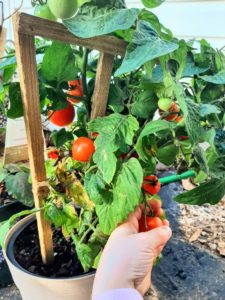 backyard or a few containers on your patio. This is another way you can help your child understand where their food comes from. Just starting one tomato plant from seed and watching its growth until they are able to pick a juicy red tomato ready to slice can give them an idea of the hard work and dedication it takes from the farmers of our nation in order for us to enjoy the vast array of food available to us.
backyard or a few containers on your patio. This is another way you can help your child understand where their food comes from. Just starting one tomato plant from seed and watching its growth until they are able to pick a juicy red tomato ready to slice can give them an idea of the hard work and dedication it takes from the farmers of our nation in order for us to enjoy the vast array of food available to us.
Teaching our children to value our food supply and food sources is an important lesson. Like many lessons they learn while homeschooling, it can be very hands-on and enjoyable. So check your local listings for a farmers market, pick-your-own farm, or produce stand near your home and be ready to plan a delicious menu from your purchases!
 Jessica Frierson is a homeschool graduate and has been homeschooling her ten children since 2000. She serves as the secretary for NCHE, writes for GREENHOUSE, and is the lead blogger for the NCHE blog.
Jessica Frierson is a homeschool graduate and has been homeschooling her ten children since 2000. She serves as the secretary for NCHE, writes for GREENHOUSE, and is the lead blogger for the NCHE blog.
Homeschool Victory Moment
by Jessica Frierson, June 2022
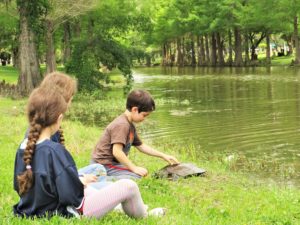 “Mom, when are we going to start school again?”, asked my daughter, looking up from the school work I had given her to do one day this spring.
“Mom, when are we going to start school again?”, asked my daughter, looking up from the school work I had given her to do one day this spring.
“You’re doing your school work right now,” I replied with a laugh.
“No, Mom, I mean our REAL school work!” she answered back before filling in the rest of the chart she was making to show the difference in germination times for the various seeds she had planted that day.
Score another point for homeschooling! That moment was one of many that I consider homeschool victory moments. My children were having so much fun learning that they didn’t even realize that was what they were doing.
We put our schoolbooks away for several weeks each spring and learn in other ways. We often take a family trip to a new destination. We get a head start on our garden by sowing seeds indoors. Summer projects get planned. New crafts or hobbies are explored. But most of all, as the world awakens from its winter nap, we spend every moment we can watching the new life spring forth.
 All of these activities encompass a host of learning opportunities. Wherever our travels may take us, I research the area as well as the route to get there ahead of time. I look for historical points of interest, museums, and unique landmarks that we can include in our visit. We look at maps to see what new places we will travel through. My children each keep a running list of the states where they’ve been. As they add a new state, they look up some facts about it, including its capital, neighboring states, chief resources, and events of key historical significance that have occurred there. We have even driven an hour out of our way simply to give them a new state to add to their list!
All of these activities encompass a host of learning opportunities. Wherever our travels may take us, I research the area as well as the route to get there ahead of time. I look for historical points of interest, museums, and unique landmarks that we can include in our visit. We look at maps to see what new places we will travel through. My children each keep a running list of the states where they’ve been. As they add a new state, they look up some facts about it, including its capital, neighboring states, chief resources, and events of key historical significance that have occurred there. We have even driven an hour out of our way simply to give them a new state to add to their list!
Planning home improvement (or self improvement) projects hones important life skills, involves higher level thinking skills, and helps a child see that they have a role to play in family life. Learning to coordinate projects with other events on the calendar and working within the family budget helps young people learn to prioritize, distinguish between needs and wants, and make decisions that are for the best interest of all. We may WANT to pressure wash the fence, paint the front porch, build a treehouse, and put in a backyard pond, but time and money may only let us choose a couple of these projects to complete this year. Including the children in the decision-making process for this has many benefits, not the least of which is preparing them to be wise and conscientious adults one day.
 Enough could not be said about all of the ways a garden enhances a child’s education. Even a young child can start some seeds in a homemade greenhouse made from recycled produce containers and be enthralled with seeing the cloud formation that takes place inside it each day when the sun’s rays shine on it. The excitement on their faces when they discover the first tips of green poking through the soil is all the reward I need to know the value of gardening for a child. And then there’s all the math and science they can do—without even realizing that they are doing math and science, as my daughter demonstrated. Pollination, germination, soil ph, evaporation, condensation, seed preservation, bed preparation, the needs of each plant for soil drainage, direct or indirect sunlight, pruning…the list is virtually endless of all the hands-on learning they get as they plan, plant, tend, and (hopefully) harvest their fruits, flowers, herbs, and vegetables.
Enough could not be said about all of the ways a garden enhances a child’s education. Even a young child can start some seeds in a homemade greenhouse made from recycled produce containers and be enthralled with seeing the cloud formation that takes place inside it each day when the sun’s rays shine on it. The excitement on their faces when they discover the first tips of green poking through the soil is all the reward I need to know the value of gardening for a child. And then there’s all the math and science they can do—without even realizing that they are doing math and science, as my daughter demonstrated. Pollination, germination, soil ph, evaporation, condensation, seed preservation, bed preparation, the needs of each plant for soil drainage, direct or indirect sunlight, pruning…the list is virtually endless of all the hands-on learning they get as they plan, plant, tend, and (hopefully) harvest their fruits, flowers, herbs, and vegetables.
The transition from spring to summer is a season of new life and growth. The world around us is full of the business of creating. This often has the effect of inspiring us to create as well. Whether we use watercolor paints, oil pastels, or a basket of broken crayons to capture them, we find a plethora of ready models beckoning to us outdoors. The birds returning to last year’s nesting place under our eaves, bees buzzing around the blossoming apple tree, squirrels scampering up and down the oak tree, and drifting pillows of clouds floating across the azure sky summon us to join them in the celebration of life.
 The spirit of industriousness is contagious, and we soon find ourselves trying a new recipe or searching for the perfect crochet pattern. My sunroom table is quickly covered with paper clay castings of animal prints discovered in the woods, special rocks, a butterfly wing, and many other wonders of nature that are the newest treasures brought to me. One child wants to know how the bees will help bring about a harvest of apples. Another is looking through a field guide to identify a new kind of bird she spotted on the fencepost. She uses an app on my phone to listen to bird calls to confirm that she has properly pinpointed it. Oh, the learning that is taking place is so great, and yet not what is typically considered “school.”
The spirit of industriousness is contagious, and we soon find ourselves trying a new recipe or searching for the perfect crochet pattern. My sunroom table is quickly covered with paper clay castings of animal prints discovered in the woods, special rocks, a butterfly wing, and many other wonders of nature that are the newest treasures brought to me. One child wants to know how the bees will help bring about a harvest of apples. Another is looking through a field guide to identify a new kind of bird she spotted on the fencepost. She uses an app on my phone to listen to bird calls to confirm that she has properly pinpointed it. Oh, the learning that is taking place is so great, and yet not what is typically considered “school.”
Spring is rapidly disappearing in our rearview mirror now. As the hot summer days arrive, our textbooks and workbooks will make a reappearance on the dining room table. We will time our outdoor activities for the cool of the day and read our way through the heat. We will take a lighter load through the summer months, balanced with lots of board games, puzzles, and some fun indoor projects. The dolls have been promised a new wardrobe so our sewing skills will be put to the test. Watching a series of baking shows has generated a list of tasty culinary experiments to eat our way through. The nature of homeschooling allows us to gift our children a love for learning about the world around us and an insatiable desire to add something beautiful and useful to that world.
will make a reappearance on the dining room table. We will time our outdoor activities for the cool of the day and read our way through the heat. We will take a lighter load through the summer months, balanced with lots of board games, puzzles, and some fun indoor projects. The dolls have been promised a new wardrobe so our sewing skills will be put to the test. Watching a series of baking shows has generated a list of tasty culinary experiments to eat our way through. The nature of homeschooling allows us to gift our children a love for learning about the world around us and an insatiable desire to add something beautiful and useful to that world.
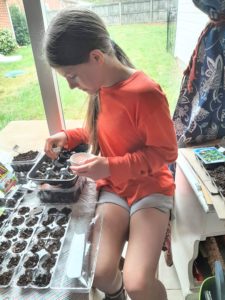 I anticipate many more homeschool victory moments ahead, whether we are in a season of book learning or have shelved the books for a while. “School never really stops, does it?” my daughter so aptly determined after I explained to her that we had been doing school for the past few weeks even as we traveled, painted, hiked, and planted. My wish for her is that it never does. That would be the ultimate homeschool victory for me.
I anticipate many more homeschool victory moments ahead, whether we are in a season of book learning or have shelved the books for a while. “School never really stops, does it?” my daughter so aptly determined after I explained to her that we had been doing school for the past few weeks even as we traveled, painted, hiked, and planted. My wish for her is that it never does. That would be the ultimate homeschool victory for me.
![]() Jessica Frierson is a homeschool graduate and has been homeschooling her ten children since 2000. She serves as the secretary for NCHE, writes for GREENHOUSE, and is the lead blogger for the NCHE blog.
Jessica Frierson is a homeschool graduate and has been homeschooling her ten children since 2000. She serves as the secretary for NCHE, writes for GREENHOUSE, and is the lead blogger for the NCHE blog.
2022 NCHE Scholarship Winners
2022 NCHE Scholarship Winners!
Since 1998, NCHE has awarded scholarships to deserving North Carolina homeschooled high school seniors. In that time, we have been blessed with support and donations from homeschool families and organizations and have been able to award more than $170,000. This year, the judges selected six amazing students.
 The 2022 recipient of the Molly Nichols Memorial Academic Scholarship is Andrew Esther, son of Julie and Charles Esther of Chapel Hill. Andrew has been active in his church’s worship band as a musician and as a leader in organizing Christmas toy drives for children. He has won several awards through Science Olympiad competitions and has been an active member of the National Homeschool Honor Society. He plans to attend Chapel Hill with an ultimate goal of becoming a cardiologist.
The 2022 recipient of the Molly Nichols Memorial Academic Scholarship is Andrew Esther, son of Julie and Charles Esther of Chapel Hill. Andrew has been active in his church’s worship band as a musician and as a leader in organizing Christmas toy drives for children. He has won several awards through Science Olympiad competitions and has been an active member of the National Homeschool Honor Society. He plans to attend Chapel Hill with an ultimate goal of becoming a cardiologist.
 The NCHE Academic Scholarship goes to John Clay, son of Debbie and Mark Clay of Fuquay Varina. John has earned the President’s Gold Service Award for three years. His major focus in community services has been with Food Pantries where he has worked weekly for five years. He plans to continue food pantry volunteering while a student at Western Carolina where he will be studying Electrical Engineering. He hopes to one day use his education and life experiences to serve with Baptists on Mission or Engineers without Borders.
The NCHE Academic Scholarship goes to John Clay, son of Debbie and Mark Clay of Fuquay Varina. John has earned the President’s Gold Service Award for three years. His major focus in community services has been with Food Pantries where he has worked weekly for five years. He plans to continue food pantry volunteering while a student at Western Carolina where he will be studying Electrical Engineering. He hopes to one day use his education and life experiences to serve with Baptists on Mission or Engineers without Borders.
 The 2022 Ernie Hodges Scholar Athlete Award goes to Calleigh Wilson, daughter of Jeana and Andrew Wilson of Winston Salem. Calleigh has been an active member of Forsyth Home Educators sports programs including swimming, softball and most notably volleyball where she has received 11 awards. She has been active in her 4-H chapter, Operation Christmas Child and Project Linus. Calleigh plans to attend Liberty for a degree in social work and hopes to one day work with children in the foster system.
The 2022 Ernie Hodges Scholar Athlete Award goes to Calleigh Wilson, daughter of Jeana and Andrew Wilson of Winston Salem. Calleigh has been an active member of Forsyth Home Educators sports programs including swimming, softball and most notably volleyball where she has received 11 awards. She has been active in her 4-H chapter, Operation Christmas Child and Project Linus. Calleigh plans to attend Liberty for a degree in social work and hopes to one day work with children in the foster system.
 The NCHE Community Service award this year is going to Sam Pasquale, son of Sam and Theresa Pasquale of Apex. Sam has been active in Civil Air Patrol where he and his CyberPatriot team placed 6th in a nationwide competition. He has trained in search and rescue exercises providing disaster relief and conducting radio communications. He has worked as a tutor at Mathnasium. Sam plans to study computer science at NC State and wants to use his skills to protect society through cybersecurity.
The NCHE Community Service award this year is going to Sam Pasquale, son of Sam and Theresa Pasquale of Apex. Sam has been active in Civil Air Patrol where he and his CyberPatriot team placed 6th in a nationwide competition. He has trained in search and rescue exercises providing disaster relief and conducting radio communications. He has worked as a tutor at Mathnasium. Sam plans to study computer science at NC State and wants to use his skills to protect society through cybersecurity.
 Kara Lewis, daughter of John and Regina Lewis of Moravian Falls is the recipient of the 2022 Arts award. She is an accomplished pianist and composer, active in American Heritage Girls, Beta Club and Uplands Reach Ministry. She is intrigued by how music scoring can add to the story line of a film and plans to pursue a Bachelors of Music in filmscoring with a cinematic arts minor at Liberty University.
Kara Lewis, daughter of John and Regina Lewis of Moravian Falls is the recipient of the 2022 Arts award. She is an accomplished pianist and composer, active in American Heritage Girls, Beta Club and Uplands Reach Ministry. She is intrigued by how music scoring can add to the story line of a film and plans to pursue a Bachelors of Music in filmscoring with a cinematic arts minor at Liberty University.
The Apologia Missions and Ministry Scholarship for 2022 goes to Kimberly McClain, daughter of Jareb and Amy McClain, currently of Durham. The McClains, however, have served for many years as missionaries to Indonesia. Kimberly is very well-rounded, participating in a variety of sports and artistic endeavors. She is an animal lover, having served as a junior wrangler at a summer camp and as a veterinary assistant apprentice at Camp Glory Farm in NC. Kimberly plans to study Christian Ministry/Education at Grove City with a hope to return to Indonesia and continue missionary work.
Please consider helping NCHE to continue to award scholarships to North Carolina homeschool seniors by donating at https://www.nche.com/scholarship-donations/
 After homeschooling and graduating all four of her children from birth through high school, Evelyn Bickley continues to invest in students and their families by serving as NCHE’s Activities Director and the advisor for a teen Gavel Club. She enjoys the hobby of letterboxing and travelling to just about anywhere but especially places that have historical significance or scenic beauty.
After homeschooling and graduating all four of her children from birth through high school, Evelyn Bickley continues to invest in students and their families by serving as NCHE’s Activities Director and the advisor for a teen Gavel Club. She enjoys the hobby of letterboxing and travelling to just about anywhere but especially places that have historical significance or scenic beauty.
Money photo by Alexander Mils on Unsplash
Five Tips for a Conference Trip
by Jessica Frierson, May 2022
 1 Look over the schedule ahead of time to see which sessions you want to attend most.
1 Look over the schedule ahead of time to see which sessions you want to attend most.
As much as you may want to, you can’t be in two places at once! There are so many great speakers at the Thrive! Conference that it can be hard to choose. If you are coming with your husband, one option is to divide and conquer. Plan ahead of time which sessions you will each attend. Take notes and share the highlights of each session with each other over dinner that evening. You can also purchase mp3 downloads of the sessions you had to miss.
Take note of the times for events outside of the speaker sessions. The keynote addresses are always a source of inspiration from our featured speakers. The talent showcase is a nice break from a day of taking in information. Our mentor table is staffed throughout the day with veteran homeschoolers who are available to share tips and strategies with you in a one-on-one setting.
 2 Dress appropriately.
2 Dress appropriately.
You will do a lot of walking at the conference. A lot. Be sure to wear comfortable shoes. You may want to dress in layers or bring a sweater as the rooms tend to be on the cool side. Bring a small rolling cart to the vendor hall to carry your purchases.
3 Use your phone camera to note items in the vendor hall that you might wish to purchase.
the vendor hall that you might wish to purchase.
Hundreds of curricula options + conference specials + no shipping costs = a great opportunity to find everything you need for your upcoming school year. To avoid impulse buying and ensure that you get just the right item, take a walk through the vendor hall on your first day. Take photos of the items that catch your eye. If you have your kids along, get their ideas as well. Look over the pictures that evening and make a shopping list for the next day.
Many of the vendors are (or were) homeschool parents themselves. Take time to talk with them about what your curriculum needs are. I have found that they truly care about helping you find the right fit for your child.
 4 Take time to recharge.
4 Take time to recharge.
Fit some downtime into each day. Take time to relax and have fun. Don’t skip meals. Staying hydrated is important also. Enjoy a hot bath at the end of the day, and be sure to get a good night’s sleep.
If you have brought your children along, making sure they have time to rejuvenate is essential to a successful conference trip. If you have come alone, take advantage of what is probably a rare opportunity to be refreshed.
 5 Make new friends. Meet up with old ones. This is your time to connect!
5 Make new friends. Meet up with old ones. This is your time to connect!
Check out the time and location of your Regional Gathering, where you can meet other families from your area. If you don’t know your region, you can find it at the same link. Our Special Gatherings are another great way to connect. The special gatherings for this year will include: military, special needs, single parents, new homeschoolers, parents of preschoolers, parents of gifted children, multicultural homeschoolers, and homeschooling with a chronic illness.
One of my favorite things about the conference is the chance to reconnect with old friends. Some go back to my early years of homeschooling in another town. Since I’ve moved, I look forward to catching up with these gals at Thrive! each year. Others are friends I have made at the conference, either while chatting at the mentor table, both grabbing for the same book in the vendor hall, or in one of the gatherings. Even my kids have formed some of their strongest friendships through encounters at the Thrive! teen programs.
Jessica Frierson is a homeschool graduate and has been homeschooling her ten children since 2000. She serves as the secretary for NCHE, writes for GREENHOUSE, and is the lead blogger for the NCHE blog.
Photo credits: sneakers photo by Benjamin Sow on Unsplash, schedule photo by John Schnobrich on Unsplash ,pillow photo by Laura Chouette on Unsplash, coffee photo by Nathan Dumlao on Unsplash, phone photo by Ghen Mar Cuaño on Unsplash.
Creating Master Writers
 by guest blogger Cheryl R. Carter, May 2022
by guest blogger Cheryl R. Carter, May 2022
I did not earn my nickname the Educational Hound Dog by accident. I can sniff out the best educational approach faster than a rabid dog can pounce on an unsuspecting turtle. I won’t flaunt my academic acumen because I recognize that my zeal for scholastic matters may be a bit excessive at times. But I do have some advice that may sound conflictual to some parents. I won’t try to sugarcoat this recommendation, so, here it is: If you have serious developing writers, you should give them time off from their academic studies for some focused writing time. I know. I know. Some of you probably think your kids put me up to that declaration. They have not. However, even if they had, it does not make my statement any less true.
Give me a bit of time to make my case. If you are raising serious writers or novelists, they need time to explore the muse seriously. It has been my experience that young writers tend to be scholastically gifted. However, their grades might not always reflect their genius. There are reasons for this phenomenon. Schools often emphasize linear thinking skills, while writers are more creative. Creative thinkers differ from linear thinkers in that they must be actively involved in their learning. Albert Einstein, by the way, was a creative thinker. He discovered the theory of relativity while doing what might be called daydreaming. Some have speculated that he mused over the thought of falling—of someone falling and not feeling their weight. Thus, daydreaming led to the discovery of the Equivalence Principle, which basically states that the way the force of gravity is felt is the same as a fictitious (not real) force felt during acceleration.
Einstein’s brilliant discoveries essentially occurred because he had the time, space, and academic freedom to be alone with his thoughts. Writers, particularly serious writers, need such time. In my writing workshop classes, gifted writers are sometimes frustrated because their lives are so regimented that they have little time for the serious muse of writing. Lest you think “well, they are just children,” Mary Shelley was a mere nineteen years old when she penned the classic Frankenstein, having begun the novel at age seventeen. S.E. Hinton was fifteen when she finished the renowned novel, The Outsiders. Christopher Paolina wrote Eragon when he was fifteen, and Harper Collins published nine-year-old Alec Graven’s book, How to Talk to Girls. These successes do not surprise me because I see similar skills in my writing scholars and my developing authors every day.
My writing workshops, clubs, and classes create an atmosphere for writing freedom. In my workshop classes, I inspire young authors to develop their muse and to give and accept criticism from other young writers. In this environment, young authors find the freedom of expression and creativity. All great writers thrive in community. Although writing is a solitary activity, history has taught us the importance of writing communities.
From your high school English classes, you probably remember learning about the famous and historic writing colonies, settlements, and communities. My online writing workshops and classes seek to recreate these environments.
Budding young writers need dedicated time with peer-creators to have their writing cheered and affirmed. The Internet has provided a means for young writers to connect with writers of similar genres and ages. My writing scholars tell me that they enjoy my classes because they get writing advice that is not just from the teacher.
I hope you decide to give your child a bit of creative freedom this school year.
 Our guest blogger today, Cheryl Carter, and her husband, Derek, are two of our featured speakers at the upcoming Thrive! Conference. Cheryl is a professor, author, homeschooling mom, and the developer of the Young Author and College Prep Writing classes where through rigor, practice, and targeted skill building, students develop their collegiate and creative writing skills. Visit www.Learn4college.com/about to learn more.
Our guest blogger today, Cheryl Carter, and her husband, Derek, are two of our featured speakers at the upcoming Thrive! Conference. Cheryl is a professor, author, homeschooling mom, and the developer of the Young Author and College Prep Writing classes where through rigor, practice, and targeted skill building, students develop their collegiate and creative writing skills. Visit www.Learn4college.com/about to learn more.
Cover photo by Emmanuel Ikwuegbu on Unsplash
Thrive!, a Family Affair
by Jessica Frierson, May 2022
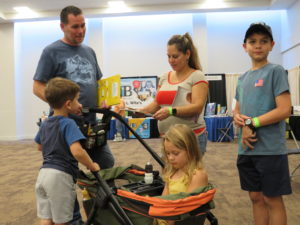 Attending a homeschool conference can be a great get-away for mom to recharge, find new materials, and get motivated for the next school year. It can serve the same purposes for the whole family, but the idea of taking everyone along may be intimidating. Here are some tips for having a great experience at the conference with the whole family.
Attending a homeschool conference can be a great get-away for mom to recharge, find new materials, and get motivated for the next school year. It can serve the same purposes for the whole family, but the idea of taking everyone along may be intimidating. Here are some tips for having a great experience at the conference with the whole family.
Stay Onsite
The number one thing you can do to make the weekend easier on everyone is to stay at one of the onsite hotels. The two hotels at the Benton Convention Center are the Embassy Suites and the Marriot. Having a hotel room accessible by simply taking the elevator up or walking across the skywalk takes a load off your shoulders at the end of a long day. You will save time by eliminating the daily commute and finding parking each day. In case of inclement weather, you can entirely avoid going outside by using the skywalk or tunnel to go back and forth between the hotel and the convention center. In fact, each of my other tips is made simpler by staying onsite.
Switch Out with Another Parent
If both parents come to the conference, you can look over the schedule of speakers, highlight the ones that are the most important to each of you, and either divide up the kids or take turns attending sessions and staying with the kids in your room. An alternative is to partner up with another homeschool mom whom your children are familiar with and who has children of a similar age range. Then, you can split up the day with one mom going to the morning sessions and the other catching the afternoon sessions. Bring board games, a big puzzle that everyone can work on together, and other activities that you can do in a hotel room. Note: don’t make the mistake I did one year when I brought non-washable crayons for a child who had not yet outgrown the desire to leave their mark on the world!
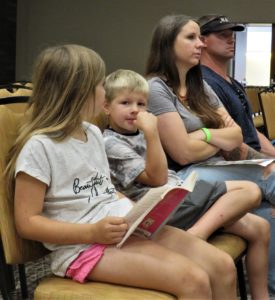 Quiet Activities
Quiet Activities
You are welcome to bring your children into the sessions with you as long as they do not disturb others, of course. In order to make this as pleasant as possible for the children and yourself, you will want to make sure they have something to occupy themselves with while you are listening to the speakers.
A floor blanket gives them a clean surface to sit on and helps those who tend to wander stay oriented where they need to be. Non-messy snacks go a long way in helping children pass the time. You may want to prepare a small backpack for each child that contains their activities. Or, you may find it more efficient to bring a small wagon that holds everyone’s items.
Activities that my children have enjoyed include paper dolls, coloring books with colored pencils (don’t forget to bring a sharpener), “Barbie”-type dolls with several changes of clothes and hair accessories, a small container of Legos and a baseplate, card or board games that don’t require talking among the players, books, Matchbox cars, small toy animals, and various travel games such as this magnetic wand or Dogpile. You can find many items that fit this list in the vendor hall. A fun way to start your conference weekend might be to walk through the vendor hall first thing. Let each child choose one item to purchase that they can enjoy right away, such as an interesting book or new card game.
Children’s Program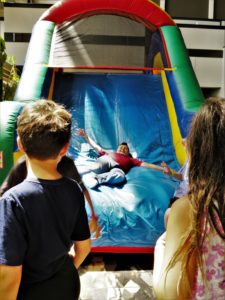
NCHE also offers a program that your children, aged 3-11, can attend while you are at the conference. The program is provided by Giant Cow Ministries and includes drama, music, Bible memorization, mentoring, and loads of fun activities such as inflatables. The pre-registration deadline is May 13. Onsite registration will be offered if there is available space.
Easy Meals
Rooms tend to sell out more quickly at the Embassy Suites, at least partly due to the included breakfast. However, If you have small children or a large family, you may find it less stressful to avoid the morning crowd and eat in your room anyway to take advantage of the rooms still available at the Marriott. Cheese sticks, instant oatmeal, cereal, granola or cereal bars, and pre-cooked boiled eggs can easily make a healthy and quick breakfast without even leaving your room.
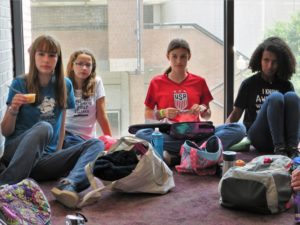 For an easy lunch, you can purchase food from vendors on the lower level of the convention center or walk to a nearby restaurant. Or have an indoor picnic with chicken salad on croissants, ham and cheese sandwiches, or egg salad tucked into pita bread. (My children view pita pockets stuffed with any filling as a festive food–maybe yours will as well.)
For an easy lunch, you can purchase food from vendors on the lower level of the convention center or walk to a nearby restaurant. Or have an indoor picnic with chicken salad on croissants, ham and cheese sandwiches, or egg salad tucked into pita bread. (My children view pita pockets stuffed with any filling as a festive food–maybe yours will as well.)
Everyone will probably be tired out from the day by dinner time. Pizza delivery may be just the thing. With Door Dash now readily available, getting take-out delivered from any nearby restaurant can be a simple solution for dinner. For a more budget-conscious approach, many families bring a slow-cooker, liners for the cooking pot, and pre-prepped ingredients for a hot meal that can be started before leaving your room for the day and ready on your return. Disposable plates and plasticware will quickly fill the small trash cans in the hotel rooms, so you may want to bring an extra trash bag from home.
A frequent request by my children that makes for an easy but nutritious meal is what they call “snack dinner.” Fresh or dried fruit, roasted nuts, hummus and whole-wheat pita wedges, cheese, crackers, olives, carrot and celery sticks with dip, pickles, and slices of deli meat offer a variety of choices for even the pickiest eaters. It’s a winner since no cooking is required, and clean-up is easy.
Active Time
With all of the focus on quiet activities, leaving out a crucial element of every child’s day would be a mistake. Although your children may be worn out from all of the walking they will likely do, they may still need an active period built into each day. Plan an activity into your schedule that will give them a chance to let out some energy. For example, a swim in the hotel pool, dancing to music on the television in your room, or a brisk walk around the block should help them get the wiggles out.
Amazing Benefits
Bringing the whole family to the homeschool conference takes a bit more planning and preparation than if mom goes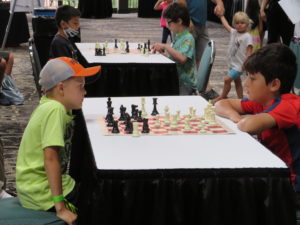 alone. However, there are many benefits to having them along with you. It will be a memorable experience that they will look forward to each year.
alone. However, there are many benefits to having them along with you. It will be a memorable experience that they will look forward to each year.
It is a great way for them to see how many other families are doing this crazy homeschool thing like them. The opportunity for your kids to look at curricula in the vendor hall may spark the fire of enthusiasm for their studies and give them a sense of power in having a say in their materials (something they would never get to do in a public school!). If they are interested in playing chess, they can participate in the chess tournament held on Thursday afternoon (preregistration is required). Watching the Talent Showcase may inspire them to try a new skill as they watch fellow homeschool students sing, dance, play instruments, and exhibit a variety of talents. And depending on their age and personality, they may be interested in some of the speakers as well.
For families with teenagers, check out the special events we have planned for them. Thursday night is filled with a cotillion-styled dance that is sure to be fun. Following the Talent Showcase on Friday night is a game social for the teens. The college fair on Friday afternoon will give them an opportunity to speak with representatives from numerous colleges and to pick up some college swag. There is also a special teen track with workshops designed with teens in mind.
It is always a blessing to walk through the convention center and observe all of the families there. My children count down the days until the next conference as soon as we get in the car to head home. It is the highlight of the year for them, and I hope it will be that for your family!

Jessica Frierson is a homeschool graduate and has been homeschooling her ten children since 2000. She serves as the secretary for NCHE, writes for GREENHOUSE, and is the lead blogger for the NCHE Blog.
What Counts as School?
by Evelyn Bickley, May 2022
 When I was a public-schooled child in Pennsylvania, the best day of the year was the one day we went on a field trip. First grade was the Philadelphia Zoo. Second was Washington’s Crossing State Park. Third was a visit to the Audubon Center. Fourth was Independence Hall and the Liberty Bell. To me, those days felt like play, but they were certainly learning experiences—and obviously memorable!
When I was a public-schooled child in Pennsylvania, the best day of the year was the one day we went on a field trip. First grade was the Philadelphia Zoo. Second was Washington’s Crossing State Park. Third was a visit to the Audubon Center. Fourth was Independence Hall and the Liberty Bell. To me, those days felt like play, but they were certainly learning experiences—and obviously memorable!
As a homeschool parent, I have continued to love field trips and count them as school days. Field trips to museums and places of historical interest are easy to identify as school. Williamsburg for a week—no brainer that this fits into American history. But what about some less usual things? When we travel to the beach, I don’t count playing on the sand as school—but I do count going to an aquarium while we’re there. Going to Disney World doesn’t count—but your students participating in Disney Imagination campus workshops would. What about touring a factory like the BMW plant in South Carolina? Yes! What about something cultural like the Greek Festival in Charlotte? Yes! What about the state fair? Well—did you just ride the rides and eat funnel cake? Then, no. But if this activity broadened your child’s horizons like getting to interact with farm animals, engaging with animal exhibitors, and learning more about what they do, or even taking a first-ever train ride to get to the fair, then I’d say yes. Whenever and wherever we travel, I try to include at least one learning field trip day into the itinerary.
 Summer camps are another area that you may—or may not—count as school. If the camp is more on the recreational side (think sleep-away camp featuring swimming, crafts, and games), I would not count that. But if your community offers a day camp at the local nature museum or science center, I would. Summer camps are also a great way to see if your child wants to pursue an interest for a longer term. My kids each tried week-long summer theater, robotics, culinary, equestrian, and athletic camps, and I happily recorded those on our school days calendar. What about Vacation Bible School? Yes, the kids are learning something, but, personally, I did not count that anymore than I counted weekly church attendance. The choice, however, is up to you.
Summer camps are another area that you may—or may not—count as school. If the camp is more on the recreational side (think sleep-away camp featuring swimming, crafts, and games), I would not count that. But if your community offers a day camp at the local nature museum or science center, I would. Summer camps are also a great way to see if your child wants to pursue an interest for a longer term. My kids each tried week-long summer theater, robotics, culinary, equestrian, and athletic camps, and I happily recorded those on our school days calendar. What about Vacation Bible School? Yes, the kids are learning something, but, personally, I did not count that anymore than I counted weekly church attendance. The choice, however, is up to you.
Many students, especially as they are in their teens, engage in community service work. These opportunities give the student the chance to learn about work ethic, showing up when expected, taking supervision from a “boss” other than the parent, and putting in a full-faith effort. These hours, as well as hours worked eventually at part-time jobs, do not count as “school” even though they are learning a lot. On the other hand, documenting these activities (especially the number of hours served if there has been significant commitment in some areas) should be included on transcripts and activities resumes if your child is going on to college.

What about other skills of everyday living? Laundry/cooking/yardwork/car maintenance? Time management? Financial management? Price comparisons in the grocery store? Compassion for a sick or injured friend or relative? I categorize these into just things you pass on to your kids regardless of the kind of public/private/homeschool in which they are enrolled. Education does not stop at the edge of a textbook for all facets of life are true learning opportunities. We cannot and do not need to quantify everything we pour into our kids or encourage them to explore. The opportunities to help them grow and learn can be boundless.
 After homeschooling and graduating all four of her children from birth through high school, Evelyn Bickley continues to invest in students and their families by serving as NCHE’s Activities Director and the advisor for a teen Gavel Club. She enjoys the hobby of letterboxing and traveling to just about anywhere but especially places that have historical significance or scenic beauty.
After homeschooling and graduating all four of her children from birth through high school, Evelyn Bickley continues to invest in students and their families by serving as NCHE’s Activities Director and the advisor for a teen Gavel Club. She enjoys the hobby of letterboxing and traveling to just about anywhere but especially places that have historical significance or scenic beauty.
photo credits: laundry photo by Sarah Brown on Unsplash, kids with parachute photo by Artem Kniaz on Unsplash, museum photo by Mihai Surdu on Unsplash
Three Ways Homeschool Parents Can Get Ready for the College Admission Process
by guest blogger Cheryl R. Carter/April 2022
 This week I met with a mother whose daughter was transitioning from a brick-and-mortar high school to homeschooling. She wanted to make sure her daughter was adequately prepared for college. More importantly, she wanted to make sure her daughter could get into the college of her choice—a very competitive, top-tier college.
This week I met with a mother whose daughter was transitioning from a brick-and-mortar high school to homeschooling. She wanted to make sure her daughter was adequately prepared for college. More importantly, she wanted to make sure her daughter could get into the college of her choice—a very competitive, top-tier college.
I suggested the following:
One: It is imperative that you find out for yourself what courses are necessary for admittance to competitive colleges. Do not just speak to other parents, although other homeschool parents can be a great resource. Go directly to the college’s website, open house, table at a college fair, or a homeschool college admissions officer. For some reason, rumors abound in the homeschool community regarding college admission because the process of moving our students on to college seems a bit mysterious, we rely on other parents, who, though meaning well, may not fully understand the process themselves.
For instance, I once spoke to a mom who insisted her son should receive a scholarship. Further, she insisted he did not need to adhere to college deadlines because he was a stellar student. The fact of the matter was the family was in dire financial straits due to her husband’s health crisis and resulting unemployment. As a result of these factors, her son got a lot of need-based aid—not scholarships! Further, he was admitted to a local university that had rolling admission. The college did not have a solid deadline. Hence, there was no deadline to miss. Truly, she was blessed that he was admitted to the college so late and was provided financial aid. However, her situation was certainly not the norm. Lesson to be learned: College admission as a homeschooler can be quite an individual matter.
Two: Make sure that your son or daughter has taken all the required classes for college admission. This effort sometimes means going beyond the standard state homeschool regulations. For instance, in New York, home-educated students are not required to take a foreign language, and while there are schools that may not require a foreign language, the more competitive schools do.
Three: Become familiar with the application process. Some schools require supplementary essays and alternative admission assessments, such as videos, portfolios, and standardized testing, such as the SAT subject tests. Note that post-COVID, some colleges have altered their admission processes. You can also help your student gain what I call the homeschool advantage by knowing what your student needs to do to become a standout candidate on their admission application.
These were just some basic tips I gave her. All homeschool parents can give their students the homeschool advantage in college admissions if they approach the college admission process with just a bit of planning.
 Our guest blogger Cheryl Carter has helped many students get into the college of their choice. Her advice is always practical and strategic. She prides herself on giving parents the homeschool advantage college admission advice. She is the author of Homeschool College Prep. Visit learn4college.com for information on her. Cheryl and her husband, Derek, are featured speakers at this year’s Thrive! Conference.
Our guest blogger Cheryl Carter has helped many students get into the college of their choice. Her advice is always practical and strategic. She prides herself on giving parents the homeschool advantage college admission advice. She is the author of Homeschool College Prep. Visit learn4college.com for information on her. Cheryl and her husband, Derek, are featured speakers at this year’s Thrive! Conference.
Stress-Free Testing
 by Jessica Frierson, April 2022
by Jessica Frierson, April 2022
Does the very thought of testing make your heart race and your stomach sick? How do you overcome testing anxiety when the time comes to meet our state requirement for standardized assessment?
NOT the Same as EOGs
It is important to understand the difference between the testing requirements that homeschoolers have and the end-of-grade testing that public schools do. According to DPI, “the North Carolina End-of-Grade Tests” for public school students “are designed to measure student performance on the goals, objectives, and grade-level competencies specified in the North Carolina Standard Course of Study.” The results affect both teachers and students. The standardized testing requirement for homeschooled students is entirely different.
The administrator of the homeschool is responsible for administering a nationally standardized achievement test–not an EOG–within the first twelve months of opening the homeschool and once annually thereafter. Who sees these results? What is done with them? NCDNPE mandates that the “records of the test results…be retained at the home school for at least one year and made available to DNPE when requested.” In the case that DNPE would request to view the test results, that is simply all they would do: glance at them to confirm that testing was done. The results themselves are irrelevant to DNPE.
Purpose for Testing
What, then, is our purpose for testing our homeschooled children? The primary purpose for many families is simply to adhere to our state law. This is often difficult for those leaving the public school system to grasp. The pressure on their child throughout the school year to be prepared for the end-of-grade testing culminates in an intense week of nail-biting tension. Did they perform well enough for promotion to the next grade?
As homeschoolers, our school structure is not based on the results of one week of testing. We, the parent-teachers, design an educational program uniquely shaped to our child’s needs. As one concept is attained, we move them on to the next one. We can move on to the next level of one subject while continuing to work on another one that they may be having more difficulty with. Promotion can be done separately between subjects rather than by the grade in general and is done entirely on a timetable that is customized for that child.
Results Are a Tool
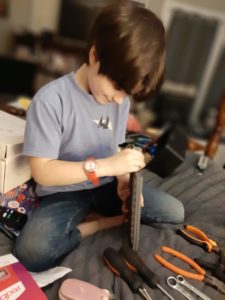 The most important thing to remember about the test results are that they are simply a tool for us to use to gauge what areas need to be strengthened. There is no pass or fail. With most tests, the results will only show a comparison of how the child performed compared to other children who took the test during the year that the test was normed.
The most important thing to remember about the test results are that they are simply a tool for us to use to gauge what areas need to be strengthened. There is no pass or fail. With most tests, the results will only show a comparison of how the child performed compared to other children who took the test during the year that the test was normed.
Some types of tests offer reports that are more precise in revealing specific areas for improvement. The Woodcock Johnson, for example, can be done with additional subtests that can give more detailed information on specific areas that you may be concerned about. Some achievement tests can be paired with a cognitive test to help determine learning difficulties, such as dyslexia.
Whichever test you decide to use for your child, the results are for your use alone. They are a tool in your large box of resources available to enhance your child’s educational experience. They neither define your child nor restrict his or her promotion. So you can both take a deep breath, relax, and approach test day with a fresh perspective.
Make It a Fun Day
 Instead of testing day being a thing to dread, make it a special day that your family can actually enjoy. You could start out with a nice breakfast. Incorporate several breaks in the testing schedule. Be sure that your child gets up and moves around or goes outside for some fresh air during their break. Have some snacks available. If the weather is nice, our family often plans a picnic lunch for testing day. If it ends up rainy, we have an afternoon tea time instead. End the day with a family movie time or play a board game.
Instead of testing day being a thing to dread, make it a special day that your family can actually enjoy. You could start out with a nice breakfast. Incorporate several breaks in the testing schedule. Be sure that your child gets up and moves around or goes outside for some fresh air during their break. Have some snacks available. If the weather is nice, our family often plans a picnic lunch for testing day. If it ends up rainy, we have an afternoon tea time instead. End the day with a family movie time or play a board game.
If your child is showing signs of fatigue or anxiety, call off testing for the day and give them a fresh start tomorrow. One way my children have turned testing into a fun event is by looking at it as something of a game in itself. I have even had them ask me if they could do it again when the test had been completed! They have guessed ahead of time which area they think they will do best in and have often surprised themselves with the outcome. However, I never permit them to compare themselves to each other.
Limit Testing’s Impact
Our children need to share the mindset that testing can have a useful purpose but is never a weapon to use against ourselves or others. It does nothing to gauge who we are as a person or to indicate that someone is better or less than another. This means that I don’t show them the percentile rankings on the test scores.
In fact, the only element of the test results that I ever share with my children is occasionally telling them, “we will work on multiplication facts next week,” if their test results indicated a weakness there. More often I will tell them, “you’ve really improved in your math skills,” or “you are really learning to spell well this year!” For the most part, we schedule a day for doing the achievement tests, make a fun day of it, then move on. After printing their results, I file them in my school folder and that’s the end of testing’s impact on our lives until the next year.
Stress-free testing is one of the many benefits of homeschooling. Test day can actually be a pleasant experience for both you and your child. Test results that are viewed in the appropriate light are a useful resource. For additional information on testing, visit NCHE’s Helps page, check out this article on selecting the best test for your child, or watch our free testing webinar.
Jessica Frierson is a homeschool graduate and has been homeschooling her ten children since 2000. She serves as the secretary for NCHE, writes for GREENHOUSE, and is the lead blogger for the NCHE Blog.





